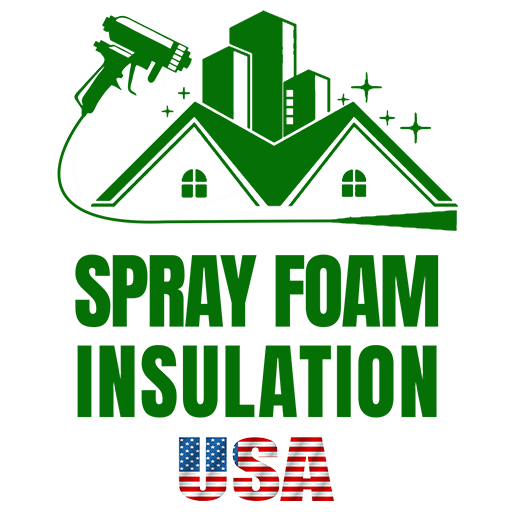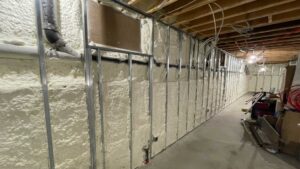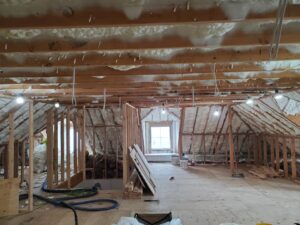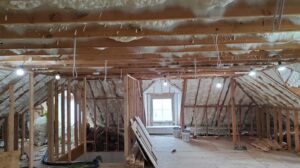Introduction
When you’re searching for ‘spray foam insulation’, you’re likely looking for an energy-efficient and eco-friendly way to reduce your energy bills and enhance the comfort of your home or business. Spray foam insulation is a standout choice for those in NY and NJ who value quality, expertise, and sustainable practices.
Spray foam insulation does more than just fill gaps; it creates a barrier that keeps heat in during the winter and out during the summer. This not only makes your space more comfortable year-round, but it also contributes to reducing your carbon footprint. Whether you’re a homeowner or a business owner, understanding the role of spray foam insulation in energy efficiency is the first step towards making an informed decision.
Why is spray foam insulation important? It seals your building envelope, preventing air leaks that can lead to high energy costs. Plus, it can improve air quality by blocking allergens and pollutants. It’s a choice that supports both your wallet and the planet.
Spray foam comes in different types: high-density, medium-density, and low-density, each with its own set of advantages depending on your needs. Knowing which type and how much you need involves considering factors such as R-values, the area to be insulated, and your specific energy efficiency goals.

In short, spray foam insulation is not just a product; it’s a pathway to more comfortable, cost-effective, and eco-friendly living and working environments. Let’s dive into the specifics of spray foam insulation, how it works, and how it can benefit you.
Understanding Spray Foam Insulation
When we talk about making our homes or buildings snug and energy-efficient, spray foam insulation is a superhero in materials. It’s not just about keeping the cold out or the warmth in; it’s about creating a continuous barrier that ups the comfort and lowers the bills. Let’s break down what spray foam insulation is all about.
Types of Spray Foam Insulation
Spray foam comes in three main types, each with its unique benefits:
-
High-Density: This is the heavy hitter of the group. With an R-value starting at 5.5 per inch, it’s a go-to for the outside of buildings and roofs. It’s like giving your home a warm hug from the outside, keeping it cozy and protected from the elements.
-
Medium-Density: A bit lighter than its high-density cousin, this foam has an R-value starting at 5.7 per inch. It’s perfect for filling up those wall cavities and making sure your attic is snug. Think of it as the middle child that’s just right for a lot of jobs.
-
Low-Density: The lightweight option, with an R-value starting at 3.6 per inch. It’s great for inside the walls and for places where you need a softer touch. It’s like the cushion that keeps your home comfortable and quiet.
R-Values: What’s the Big Deal?
You might be wondering, “What’s an R-value, and why should I care?” Well, R-value is all about resistance to heat flow. The higher the R-value, the better insulation is at keeping heat in or out, depending on what you want. So, when you’re choosing your spray foam, think about what you’re trying to achieve and pick the foam that gives you the best bang for your buck in terms of R-value.
- High R-value = Better Insulation: It’s like comparing a thin jacket to a thick winter coat. You want the coat that keeps you warmest, right? Same with your home. More R-value means more coziness and less money spent on heating or cooling.
Choosing the Right Type for Your Project
Now, you might be scratching your head, thinking, “Which foam do I choose?” Here’s a quick guide:
- For the Roof or Exterior: Go with high-density. It’s strong and has a high R-value, perfect for battling the elements.
- For Walls and Attics: Medium-density is your friend. It seals things up tight and has a great balance of strength and insulation power.
- For Interior Comfort: Low-density foam is what you need. It’s great for reducing noise and making your living space just right.
In the end, spray foam insulation is a bit like choosing the right tool for the job. You wouldn’t use a hammer to screw in a lightbulb, right? Same here. Pick the foam that fits your needs, and you’ll be on your way to a more comfortable, energy-efficient home.
And remember, it’s not just about the immediate comfort. Choosing the right spray foam insulation can mean savings on your energy bills and a smaller carbon footprint over time. So, you’re not just making your space better for today; you’re investing in a greener, more sustainable future.
Let’s move on to the next section where we’ll dive into the costs associated with spray foam insulation and what factors you need to consider.
The Cost Factors of Spray Foam Insulation
When you’re ready to take the step towards a more energy-efficient home with spray foam insulation, understanding the factors that influence cost is crucial. Let’s break it down into simple, easy-to-understand pieces: Material, Labor, Square Footage, Thickness, and Location.
Material
The type of spray foam you choose plays a big role in the overall cost. There are two main types: open-cell and closed-cell. Open-cell foam is lighter and less expensive, typically used for interior applications. Closed-cell foam is denser, offering higher R-values and moisture resistance, making it suitable for both interior and exterior applications. The material choice will significantly impact your project’s budget.
Labor
The complexity of installing spray foam insulation means it’s not a DIY job for most people. The cost of professional installation can vary widely depending on the expertise of the installer and the specific requirements of your project. Skilled professionals are necessary to ensure the foam is applied correctly and efficiently, adhering to building codes and manufacturer instructions.
Square Footage
Simply put, the more area you need to insulate, the more it will cost. Spray foam insulation is typically priced by the board foot (a unit of volume), so larger spaces require more material, increasing the price. However, because spray foam expands to fill spaces, it can be more cost-effective for insulating large, irregularly shaped areas compared to traditional insulation materials.
Thickness
The thickness of the spray foam applied affects both its insulating properties and its cost. Thicker applications provide higher R-values, meaning better thermal resistance and energy efficiency. However, they also require more material, which can increase the cost. Deciding on the right thickness involves balancing your insulation needs against your budget.
Location
Where you live can influence the cost of spray foam insulation. Factors like the local climate, building codes, and the cost of living can all affect how much you’ll pay. For example, homes in colder climates might benefit more from closed-cell foam’s higher R-values, making it a more cost-effective choice despite its higher initial price.
In summary, several factors will determine the cost of spray foam insulation for your home. By understanding these factors, you can make informed decisions that balance cost with the performance and energy savings spray foam insulation can provide. Investing in quality insulation is not just about the upfront costs—it’s about the long-term savings on your energy bills and the increased comfort of your home.
As we move into the next section, we’ll explore the advantages of choosing spray foam insulation, from energy savings to creating a healthier living environment.
Advantages of Choosing Spray Foam Insulation
When you’re thinking about how to make your home more energy-efficient, comfortable, and sustainable, spray foam insulation stands out as a smart choice. Let’s dive into the key benefits that make spray foam insulation a top pick for homeowners.
Energy Savings
One of the biggest advantages of spray foam insulation is the potential for huge energy savings. Because spray foam creates a tight seal, it significantly reduces air leaks. This means your heating and cooling systems don’t have to work as hard to maintain a comfortable temperature in your home. Over time, this can lead to substantial savings on your energy bills. In fact, homes insulated with spray foam can start seeing cost reductions from day one.
Air Barrier
Spray foam insulation acts as an effective air barrier. This is crucial because leaks can cost you a bundle. By adding even just 1 inch of spray foam to your home, you can drastically reduce unwanted air leaks. This not only helps with energy savings but also improves the overall comfort of your home by eliminating drafts.
Vapor Retarder
Moisture can be a big problem in homes, leading to mold growth and structural damage. Spray foam insulation serves as a vapor retarder, essentially waterproofing your home’s insulated areas. This is especially important in regions prone to high humidity or those that experience significant seasonal changes.
High R-Value
The R-value of insulation measures its ability to resist heat flow. The higher the R-value, the better the insulation’s effectiveness. Spray foam insulation boasts an extremely high R-value compared to other insulation types, offering superior insulation per inch. This means you get more bang for your buck in terms of insulating power, helping to keep your home warm in the winter and cool in the summer.
Sustainability
Choosing spray foam insulation is also a step towards a more sustainable future. The materials used in spray foam are designed to have a lower environmental impact, and by reducing your home’s energy consumption, you’re also reducing your carbon footprint. It’s a win-win for both your wallet and the planet.
In summary, spray foam insulation offers a range of benefits that go beyond just insulating your home. From significant energy savings to enhancing your home’s sustainability, it’s clear why many homeowners are making the switch to spray foam. As we continue to explore insulation, keep these advantages in mind when considering the best option for your home.
Common Misconceptions and Concerns
When it comes to spray foam insulation, there are a few topics that often confuse or concern homeowners. Let’s clear up some of the most common misconceptions and address these concerns directly.
Shrinkage
A common worry is that spray foam insulation will shrink over time, compromising its effectiveness. However, when properly installed, spray foam insulation is designed to maintain its shape and volume. It’s crucial that the installation is done by professionals who understand the product and the science behind it. This ensures that the foam expands correctly and adheres well, eliminating concerns about shrinkage affecting its insulating properties.
Application Areas
Many people wonder about the best places in a home for spray foam insulation. The truth is, spray foam is incredibly versatile. It can be applied to roofs, walls, floors, and around windows and doors. Its ability to create an airtight seal makes it ideal for both new constructions and renovations in older homes. However, it’s important to consult with experts, as the choice between open-cell and closed-cell spray foam will depend on the specific needs of each area, such as moisture control or the need for a vapor barrier.
DIY Challenges
The idea of DIY spray foam insulation might seem appealing for those looking to save on costs. While it’s true that you can apply spray foam insulation yourself, it’s not as simple as it might seem. The process requires precise preparation, the right equipment, and a good understanding of the product. Safety is also a major concern, as improper handling can lead to off-gassing of volatile organic compounds (VOCs). For these reasons, it’s usually best to leave the job to professionals who have the experience and equipment to ensure it’s done safely and effectively.
Moisture Issues
One of the biggest concerns homeowners have is about moisture. How does spray foam insulation handle moisture? Can it lead to wood rot or mold? Properly installed spray foam insulation actually helps manage moisture in a home. It creates an airtight seal that prevents warm, moist air from entering and condensing within walls. However, issues can arise if the foam is incorrectly applied. For instance, without proper ventilation or if the foam obstructs necessary airflow in attics or crawl spaces, moisture problems can occur. That’s why work with knowledgeable installers who understand how to balance insulation with proper home ventilation.
In addressing these common concerns, it’s clear that the effectiveness of spray foam insulation largely depends on proper installation and choosing the right product for your specific needs. By consulting with professionals and ensuring that the application is done correctly, homeowners can enjoy the many benefits of spray foam insulation without worry.
Remember that addressing these misconceptions and concerns is key to making informed decisions about insulating your home. Let’s now dive into some frequently asked questions about spray foam insulation to further clarify any uncertainties you might have.
FAQs on Spray Foam Insulation
Is Spray Foam Insulation Worth the Investment?
Yes, it is. Spray foam insulation can seem pricey upfront, but it’s a smart investment for several reasons. First, it offers significant energy savings. Homes insulated with spray foam can see up to 40% reduction in energy bills. This is because spray foam provides an excellent air barrier and vapor retarder, which traditional insulation types don’t always offer. Over time, these savings can more than cover the initial cost of the spray foam.
Moreover, spray foam has a long lifespan. It’s designed to last 80 to 100 years, maintaining its effectiveness without sagging or compressing. This durability means you likely won’t have to re-insulate your home again, saving money in the long run.
Can Spray Foam Insulation Be Installed in Older Homes?
Absolutely. Spray foam insulation can be a great choice for older homes. However, it’s important to approach this with care. Older homes weren’t built with the same materials or methods as modern homes, so they “breathe” differently.
When installing spray foam in an older home, professionals need to ensure it won’t trap moisture, which could lead to wood rot. Properly applied, spray foam can actually help seal leaks and gaps, making the home more energy-efficient without compromising its structure. Always consult with a professional who understands the unique needs of older homes to ensure the best outcome.
How Does Spray Foam Insulation Compare to Traditional Insulation?
Spray foam insulation stands out from traditional materials like fiberglass or cellulose in several key ways:
-
Energy Efficiency: With high R-values ranging from R-3.5 to R-6.5 per inch, spray foam often outperforms traditional insulation types, which have lower R-values.
-
Air Sealing: Spray foam expands to fill gaps and cracks, creating an airtight seal. This helps prevent air leaks, a major cause of energy loss in homes. Traditional insulation doesn’t provide the same level of air sealing.
-
Moisture and Pest Resistance: Spray foam is resistant to moisture and can help deter pests, adding an extra layer of protection for your home. Traditional insulation materials can absorb water and may be damaged by pests.
-
Longevity: Spray foam’s long lifespan means it’s a one-time investment for many homeowners. Traditional insulation may need to be replaced or supplemented over time to maintain its effectiveness.
In conclusion, while traditional insulation types have their uses, spray foam insulation offers a combination of benefits that can enhance your home’s comfort, energy efficiency, and long-term value.
As we’ve explored these FAQs, it’s clear that spray foam insulation is a versatile and effective solution for a wide range of homes. Whether you’re looking to upgrade an older home or build a new one, spray foam offers benefits that traditional insulation simply can’t match. In the next section, we’ll wrap up our comprehensive guide by discussing the long-term benefits of choosing Spray Foam Insulation USA for your insulation needs.
Conclusion
Long-Term Benefits
Choosing spray foam insulation is more than just an upgrade to your home; it’s an investment in your future. With its superior sealing capabilities, high R-value, and resistance to moisture and air infiltration, spray foam insulation can drastically reduce your energy bills. Over time, these savings add up, potentially offsetting the initial cost of installation.
But the benefits don’t stop at energy efficiency. By creating a more comfortable and consistent indoor climate, spray foam insulation can enhance the overall livability of your home. This improvement in comfort is something you’ll notice every day, from the reduced need for heating and cooling to the absence of drafts and cold spots.
Moreover, spray foam insulation contributes to a healthier home environment. Its ability to seal out pollutants, allergens, and moisture helps protect you and your family from potential health risks, such as respiratory issues and mold growth.
Spray foam insulation is also incredibly durable, with a lifespan that can extend up to 80-100 years if properly installed. This longevity means that once you invest in spray foam insulation, you may never need to replace it for as long as you own your home.
Spray Foam Insulation USA
At Spray Foam Insulation USA, we understand the importance of making your home as energy-efficient and comfortable as possible. We pride ourselves on providing high-quality spray foam insulation services that cater to your specific needs. Our team of experts is committed to helping you achieve the best possible results for your home, ensuring that your investment in spray foam insulation delivers maximum benefits in terms of energy savings, comfort, and overall home health.
Choosing us means you’re not just getting a service; you’re gaining a partner dedicated to enhancing your home’s efficiency and comfort. With our expertise and commitment to quality, Spray Foam Insulation USA is your go-to source for all your insulation needs, ensuring that your home is well-protected, energy-efficient, and comfortable for years to come.
In conclusion, investing in spray foam insulation offers a multitude of long-term benefits that go beyond simple energy savings. It’s about creating a healthier, more comfortable home environment that you and your family will enjoy for decades. And with Spray Foam Insulation USA, you have a trusted partner ready to make that investment as rewarding as possible.





